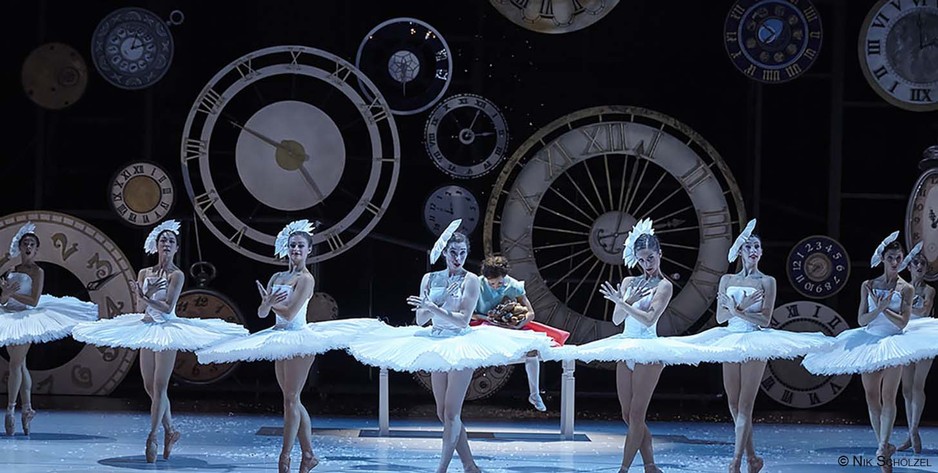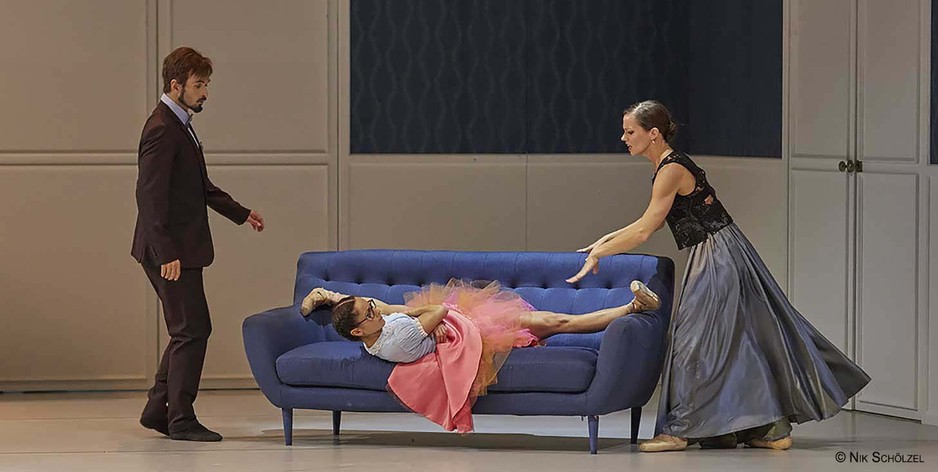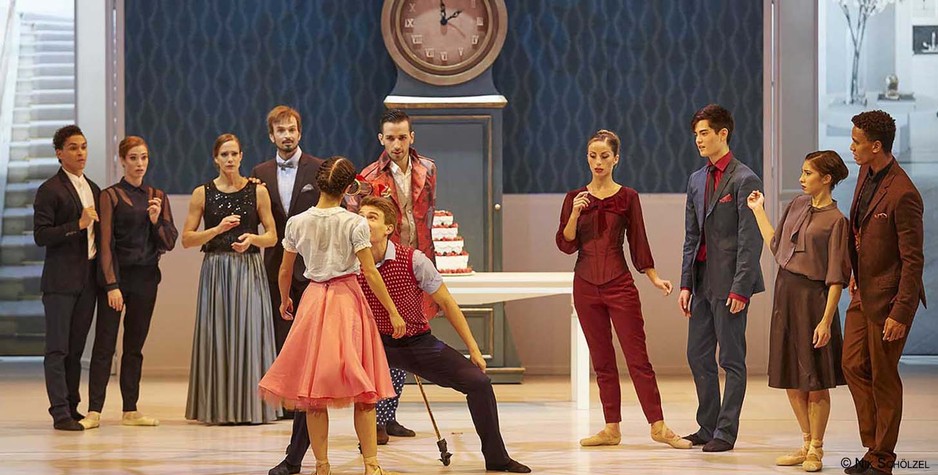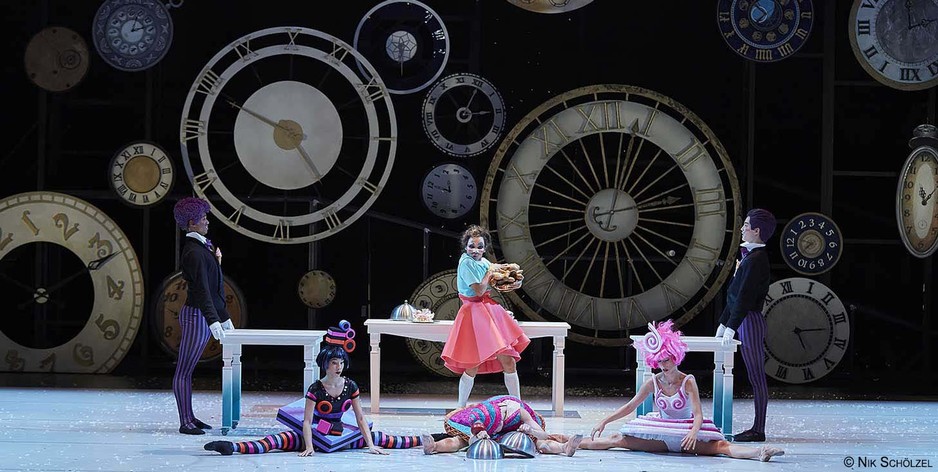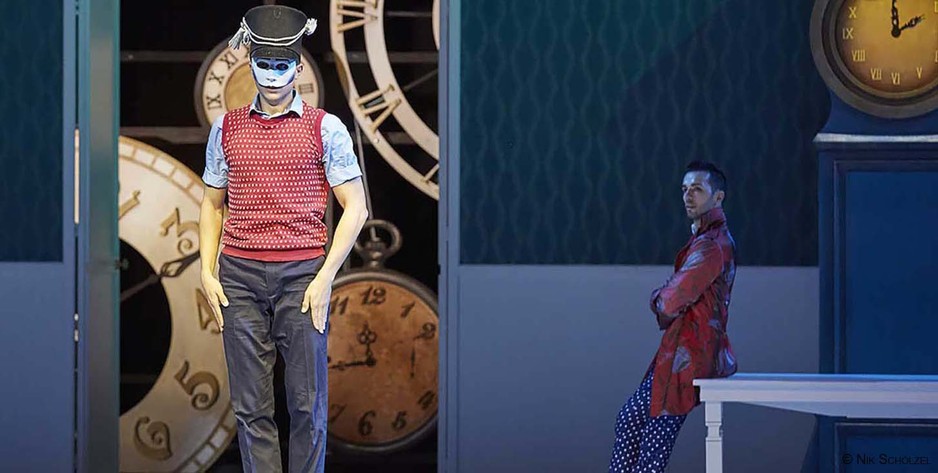Lo Schiaccianoci - MdC
Menu principale:
Pagine Nascoste
Lo Schiaccianoci
Musica: Peter I. Tschaikowsky
Scena, costumi: Margrit Flagner, Mauro de Candia
Drammaturgia: Patricia Stöckemann
Prima: 2 ottobre 2016, Augusta
Compagnia: Augsburg Ballet, Germania
Music: Peter I. Tschaikowsky
Set, costumes: Margrit Flagner, Mauro de Candia
Dramaturgy: Patricia Stöckemann
Premiere: October 2nd 2016, Augsburg
Company: Augsburg Ballet , Germany
Since its first performance in 1892 in St. Petersburg
At the core of the complex story is the figure of Marie, who is given a Nutcracker by her godfather Drosselmeyer. In her dream her love for him transforms him into a prince, whereupon they travel together into the Kingdom of the Toys and the Land of Sweets
In his version, Mauro de Candia takes a close look at a fairy-tale which is deeply-rooted in the ballet tradition. Using Hoffmann’s literary work and Tchaikovsky’s music, he created an ambiguous world between reality and dream. Ambivalence and magic is omnipresent in the figures and the scenes: in the clairvoyant, adolescent Marie, in the strangely bizarre Drosselmeyer, in the two-fold character Nutcracker/Prince. All three of them – who are already previously connected with one another – appear to be gifted with more sensory perception than the people surrounding them. The invisible becomes visible, the dream becomes reality.
PRESS REVIEW
De Candia has a completely open-minded approach to this work, changes the music around and dusts off the story, especially as regards the dancing prowess in the typical Divertissements.
Instead, he tells the compelling story of Marie, the (delightfully!) naughty teenager on the way to becoming a loving young woman, thus drawing heavily on the original tale “Nutcracker and Mouse King” by E.T.A. Hoffmann. A fairy-tale which so clearly examines the child-like, girlish psyche.
De Candia’s style is at times en pointe, then whole-footed, or even down on the floor, and is thus not only up-to-date and natural, but also increases the expressive depth of the characters.
The costumes by Margit Flagner are elegant and humorous, ingenious and pointed, furnished with a special appreciation for fine colour harmonies and help to perfectly establish the character of the roles.
This up-to-date, although never disenchanted “Nutcracker” is a delight for the whole family.
Barbara Angerer-Winterstetter, www.donaukurier.de, 04/10/2016
The Italian has given the piece a hefty shake-up, put it back together again (also changing the order of the musical pieces) and also added some new idea
Just like the literary original, Mauro de Candia’s production appeals at various levels: It is imaginative and visually powerful and offers a wonderful visit to the theatre for the whole family. One gains a feeling for the yearnings, irritations and depths of an adolescent.
There is, of course, no lack of outstanding dance scenes in this “Nutcracker”, even without a Sugarplum Fairy and other character dances.
De Candia has created a neo-classical choreography, in which there is room for hip-hop as well as caricaturing elements. However, the choreographer takes the story-line and the characters seriously.
The audience was over the moon.
Birgit Müller Bardorff, Augsburger Allgemeine, 4/10/2016
The choreographer Mauro de Candia, dramaturgically well-supported by Patricia Stöckemann, uses the literary phantasmagoria “Nutcracker and Mouse King” by E.T.A. Hoffmann, which offers much more in-depth psychology and is more consistent in its storyline.
With elegant scenery and costumes designed by Margrit Flagner, he has staged his version of the popular Tchaikovsky ballet with an instinct for humour and cloaked it, for the most part, in modernized Neoclassic. Without question, the dance highlight was the pas-de-deux, where Tamas Derai, as the spurned nephew, is able to make his real strengths clear, thus winning over Marie’s heart with his zeal and jumping power.
Renate Baumiller-Guggenberger, a3kultur.de, 5/10/2016
His (de Candia’s) key figure is a frustrated 15 year-old Marie (wonderfully truculent and impudent: Michela Paolacci). Her problem is her stuffy parents, who can’t even think of a suitable birthday present for the adolescent. The knights in shining armour are Drosselmeyer (masterful: Riccardo De Nigris as Master of the Clocks) and his young nephew (Nutcracker/Prince: Tamas Darai). They are somehow different – as is the telescope, which they have brought for Marie. When the girl looks through it her familiar and boring world is suddenly turned on its head.
The grandfather clock in the living room becomes a portal, through which Marie follows Drosselmeyer into the realm of the ugly princess Pirlipat.
In the course of her dream Marie once again meets the Nutcracker/Prince. She merges with Pirlipat’s figure and helps to drive away the nasty mice. Their holding hands develops into a grandiose, deeply affectionate pas-de-deux. A vision, which Marie takes with her into the future, when she wakes up crouching in the clock-case.
Vasna Mlakar, Dance for You Magazine, December 2016
Conclusion: You, as choreographer, must come up with a version of Tchaikovsky’s ballet, which can entertain children while, at the same time, can be understood as a “childhood psychological study” by the adults. And this is what the Director of the Osnabrücker Dance Company, Mauro de Candia, has, for the most part, succeeded in doing. Margrit Flagner’s set design gives him a space which hardly needs any changes, while Marie develops very quickly from a small child into a pubescent teenager, who is neither satisfied to be put into a salmon-pink dress, nor with a nutcracker as a present. Somebody has obviously given the matter a lot of thought and given the choreographer a wonderful opportunity, which Mauro de Candia has made the most of, especially in the first act. A maturing process in nuce, which turns the performance into an event.
Hartmut Regitz, Tanz, December 2016
Sin dalla sua prima rappresentazione nel 1892 a San Pietroburgo, Lo Schiaccianoci, con musiche di Peter I. Tchaikovsky, si è affermato come uno dei più grandi e amati classici del 19° secolo.
Basato sul racconto fantastico di E.T.A. Hofmann Schiaccianoci e il re dei topi, la versione del balletto ha visto, anche nelle successive interpretazioni, deliziare il pubblico fino ai giorni nostri.
Al centro della complessa trama vi è la figura di Marie, a cui viene regalato uno Schiaccianoci dal suo padrino Drosselmeyer. Nel suo sogno il suo amore per lui lo trasforma in un principe, dopo di che viaggiano insieme nel Regno dei giocattoli e la terra dei dolci.
Nella sua versione, Mauro de Candia osserva da vicino una fiaba profondamente radicata nella tradizione del balletto. Usando l'opera letteraria di Hoffmann e la musica di Ciajkovskij, crea un mondo ambiguo tra realtà e sogno. L'ambivalenza e la magia sono onnipresenti nelle figure e nelle scene: nella perspicace e adolescente Marie, nello strano e bizzarro Drosselmeyer, nel doppio carattere Schiaccianoci/Principe. Tutti e tre - connessi in precedenza già l'uno con l'altro - sembrano dotati di una percezione più sensibile rispetto alle persone che li circondano.
L'invisibile diventa visibile, il sogno diventa realtà.
ESTRATTI STAMPA
De Candia porta un approccio completamente fresco al lavoro, rivedendo l´ordine cronologico musicale e rispolverando la storia, in particolare per quanto riguarda la capacità di ballare i tipici Divertissements.
Piuttosto, racconta l'avvincente storia di Marie, l'adolescente (deliziosa!) impertinente sulla strada per diventare una giovane donna amorevole, attingendo maggiormente al racconto originale "Schiaccianoci e il re dei topi" di E.T.A. Hoffmann. Una fiaba che esamina con estrema chiarezza la psiche infantile e l’età fanciullesca.
Lo stile di de Candia è a volte in punta, poi in mezza punta, o addirittura al suolo, ed è quindi non solo attuale e naturale, ma ne aumenta anche la profondità espressiva dei personaggi.
I costumi di Margit Flagner sono eleganti e spiritosi, ingegnosi e intelligenti, conun particolare apprezzamento per le armonie di colori che aiutano a stabilire perfettamente il carattere dei ruoli. Questo "Schiaccianoci" rivisitato, anche se mai disincantato, è una delizia per tutta la famiglia.
Barbara Angerer-Winterstetter, www.donaukurier.de, 04/10/2016
L'italiano ha dato al balletto una forte scossa, l'ha rimesso insieme (cambiando anche l'ordine dei brani musicali) aggiungendo anche alcune nuove idee.
Proprio come nell'originale fonte letteraria, la produzione di Mauro de Candia affascina su vari livelli: è fantasiosa e visivamente potente e offre una meravigliosa serata a teatro per tutta la famiglia. Si leggono i desideri, le irritazioni e i sentimenti profondi di un adolescente.
Non si avverte nessuna carenza nelle importanti di scene di ballo in questo "Schiaccianoci", anche senza la Fata confetto e i personaggi delle danze di carattere.
de Candia ha creato una coreografia neoclassica, in cui c'è spazio per l'hip-hop e per gli elementi caricaturali. Tuttavia, il coreografo prende sul serio la trama e i personaggi.
Il pubblico era al settimo cielo.
Birgit Müller Bardorff, Augsburger Allgemeine, 4/10/2016
Il coreografo Mauro de Candia, ben sostenuto drammaturgicamente da Patricia Stöckemann, utilizza la fantasmagoria letteraria "Schiaccianoci e il re dei topi" di E.T.A. Hoffmann, che offre una psicologia molto più approfondita ed è più coerente nella sua trama.
Con eleganti scenografie e costumi disegnati da Margrit Flagner, ha messo in scena la sua versione del famoso balletto di Čajkovski con senso dell'umorismo e avvolgendolo, per la maggior parte, in uno stile neoclassico attuale.
Senza dubbio, il punto di danza culminante è stato il passo a due dove Tamas Derai, il nipote respinto, mostra le sue qualità, conquistando così il cuore di Marie con la sua premura e i suoi salti potenti.
Renate Baumiller-Guggenberger, a3kultur.de, 5/10/2016
La sua (di de Candia) figura chiave è la frustrata quindicenne Marie (meravigliosamente ribelle e sfacciata: Michela Paolacci). Il problema sono i suoi genitori soffocanti, che non riescono nemmeno a pensare ad un regalo di compleanno adatto ad una adolescente.
I cavalieri dall’armatura splendente sono Drosselmeyer (magistrale: Riccardo De Nigris nel ruolo di Maestro degli orologi) e il suo giovane nipote (Schiaccianoci/Principe: Tamas Darai). Questi sono in qualche modo diversi, come il telescopio che regalano a Marie. Quando la ragazza lo guarda, il suo noioso mondo familiare viene improvvisamente rovesciato.
Addormentandosi Marie segue Drosselmeyer nel regno della brutta principessa Pirlipat. Nel corso del suo sogno, Marie incontra nuovamente lo Schiaccianoci/Principe. Si immedesima nella figura di Pirlipat e aiuta a scacciare i topi cattivi. La loro mano nella mano si trasforma in un passo a due grandioso e profondamente affettuoso.
Una visione che Marie porta con sé nel mondo reale, quando si risveglierà accovacciata nella cassa dell'orologio.
Vasna Mlakar, Dance for You Magazine, December 2016
In conclusione: come coreografo devi inventare una versione del balletto di Čajkovskij che può intrattenere i bambini mentre, allo stesso tempo, può essere inteso come uno "studio psicologico infantile" da parte degli adulti. Ed è ciò che il direttore della Compagnia di danza di Osnabrück, Mauro de Candia, è riuscito a fare per la maggior parte.
La scenografia di Margrit Flagner gli regala uno spazio che non ha quasi bisogno di modifiche, mentre Marie cresce rapidamente da bimba ad adolescente, che non è né soddisfatta di essere vestita con un abito rosa salmone, né da uno schiaccianoci come regalo. Qualcuno ha ovviamente pensato molto alla questione e ha dato al coreografo una meravigliosa opportunità, che Mauro de Candia ha sfruttato al massimo, specialmente nel primo atto. Un processo di maturazione delizioso, che trasforma la performance in un evento.
Hartmut Regitz, Tanz, December 2016
